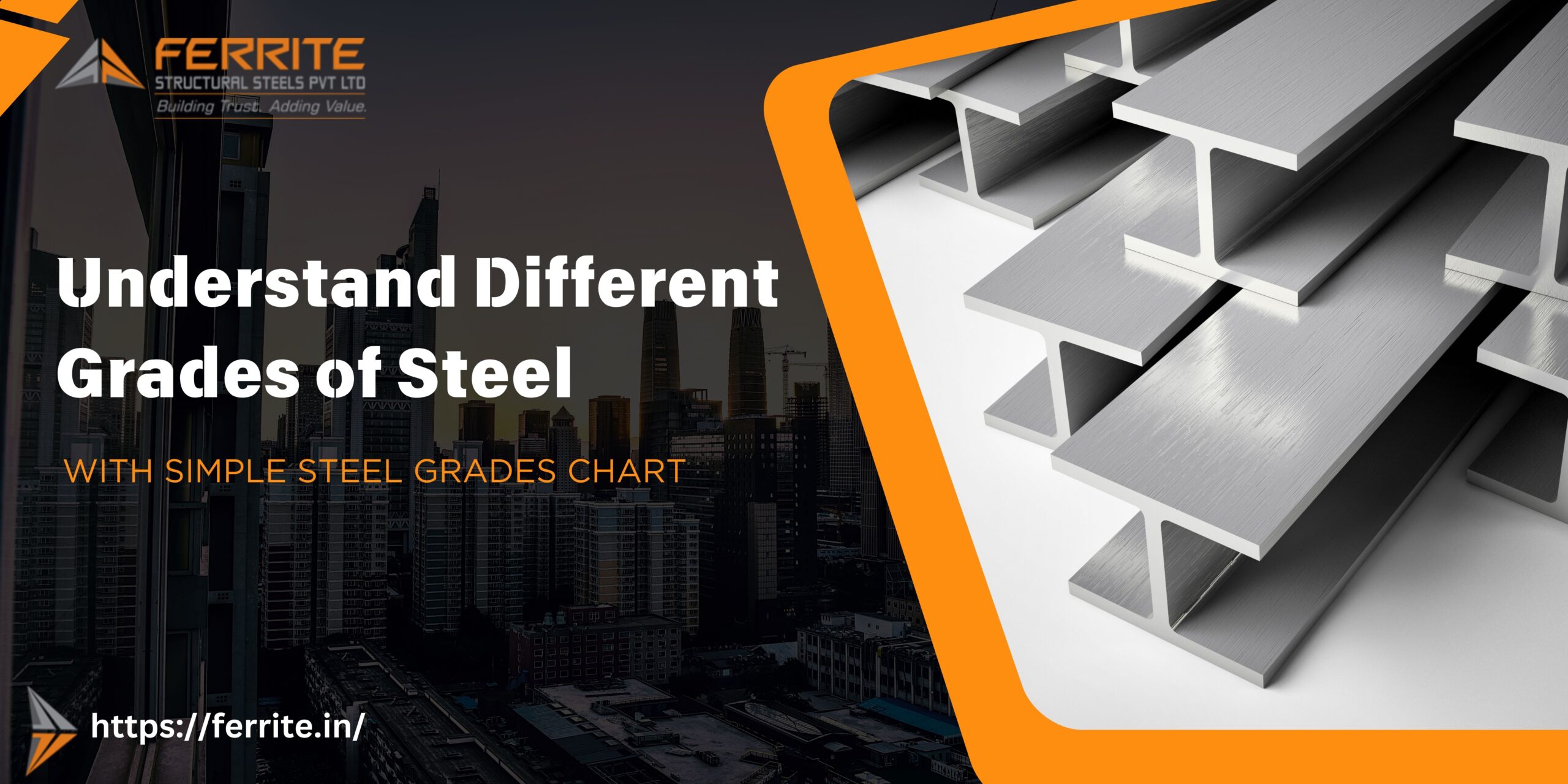In India, steel has become a crucial component in the construction industry due to its strength, flexibility, and durability. However, choosing the right type of steel for a construction project can be challenging with the variety of grades available. Each grade of steel offers different properties, making it suitable for specific applications. This article will explain and break down different types and grades of steel commonly used in India so that the reader can easily understand how they are used in construction.
What Are Steel Grades and Why Are They Important?
Steel is an alloy based mostly on iron, with the carbon and other elements being present in minute amounts, which are responsible for its properties. Steel grades are classified by composition and characteristics. There are various grades of steel, and each one is created for different uses. Such as, when a steel type is to be selected for construction projects in India, it is absolutely necessary to know, which grade is the most suitable steel for the job in hand.
Types of Steel Commonly Used in Construction
Let’s explore the different types of steel and their grades commonly used in the construction industry.
1. Carbon Steel
Carbon steel accounts for the greatest share of all steel as it includes not only strength and hardness but also an economy. This kind of steel has a lower count of carbon but still makes it stronger, counteracting its ductility. Three divisions can be identified in the carbon steel main category:
- Low Carbon Steel (Mild Steel): Is the steel with a carbon content from 0.05% to 0.25% which is not resisting forces. Being flexible one can shape and weld it easily. It is mostly employed in structural applications such as beams and columns.
- Medium Carbon Steel: This material with a carbon content of 0.25%-0.60% has a performance, in terms of strength and hardness, which is higher than that of mild steel, although it is not as flexible. It is frequently used as a main body material when strength is the most important characteristic.
- High Carbon Steel: The steel contains the highest proportion of 0.60%-1.4% of carbon thus producing a very hard and so-called brittle material to a certain degree. Provided its not high flexibility, it is not only the disadvantage but also the fact that it is widely used in construction. However, it has been used in the more limited but very specialized commercial field, e.g. in the tool industry and high-strength wires.
Popular Grades of Carbon Steel in India:
- IS2062 Grade B: This grade of mild steel is used in structural applications and general construction.
- C45: Known for its toughness, C45 is used in engineering applications like machinery and tool-making.
2. Stainless Steel
Stainless steel is mainly known for its corrosion resistance and aesthetic appearance. A minimum of 10.5% chromium, which creates a protective layer to inhibit rust, is contained. Stainless steel that has this quality of erosion tolerance, is widely used in building industry, especially in coastal areas, façades, and interior fittings.
Stainless Steel Grades for Construction:
- 304 Grade Stainless Steel: Generally, the name “workhorse” of stainless steel is often associated with this grade material that is rust-resistant and easy to process. It is, however, typically used in the areas of railings, architectural finishes, and structures that are open to the natural elements.
- 316 Grade Stainless Steel: The inclusion of molybdenum in this grade also increases the corrosion resistance property mainly in salty surroundings. However, it is mostly used in coastal constructions and other regions with a high moisture level.
Thus, the study of stainless steel grade charts can help you in determining the different types of stainless steel available and their specific uses.
3. Alloy Steel
Alloy steels are produced by adding elements especially manganese, nickel, or chromium to carbon steel and this is the key to the change of composition, strength, toughness, or heat resistance of the steel. Alloy steels are utilized in buildings and other things that need good strength.
Popular Alloy Steel Grades:
- EN24: Known for its strength and toughness, EN24 is commonly used in heavy-duty applications.
- IS 6917: This is a high-strength grade used in industrial and commercial buildings.
4. Mild Steel
Mild steel or low carbon steel is a material that is often used in construction in India due to its easy availability and the low cost. It has the property of weldability, shaping, and cutting facility that can be used in the number of construction works.
Mild Steel Grades:
- IS2062 Grade A and B: This is the most common mild steel grade in India, used for structural applications like beams and columns in buildings.
- Fe 250, Fe 275, and Fe 410: These mild steel grades are used in structural applications due to their strength and ease of fabrication.
Comparing Steel Grades with a Chart
It can easily compare different types of steel and their use with the help of a chart on the grades of steel. Very well, explained characteristics and use of each grade could be seen with the help of this chart.
| Steel Type | Common Grades | Properties | Uses in Construction |
| Carbon Steel | IS2062, C45 | Strong, low cost, weldable | Structural frames, beams, columns |
| Stainless Steel | 304, 316 | Corrosion-resistant, aesthetic | Exterior facades, railings, coastal areas |
| Alloy Steel | EN24, IS 6917 | High strength, wear-resistant | Heavy-duty structures |
| Mild Steel | Fe 250, Fe 410 | Affordable, flexible | General construction, reinforcing bars |
This chart provides a clear understanding of different steel grades and their best uses in construction.
Choosing the Right Steel for Your Project
Follow this factors while choosing the most suitable steel type for you:
- Strength requirements: Different grades offer different strength levels. For example, alloy steel and high-carbon steel are the materials of choice for heavy-duty structures that must withstand a large amount of load and stress.
- Corrosion Resistance: In humid and coastal areas, stainless steel grades 304 or 316 are preferred since they resist rust.Budget Constraints: The use of mild steel, which is less expensive and more adaptable is the usual one for general construction activities.
Applications of Steel Products in Indian Construction
Such a huge number of steel products are manufactured and sold: bars, sheets, pipes, beams, etc. are used in various areas:
- Reinforcing Bars (Rebars): Mild steel rebars which are used in casting concrete are the steel reinforcing materials.
- Steel Sheets and Plates: The carbon and stainless steel plates are used in construction equipment, bridges, and buildings.
- Steel Beams and Columns: The structural beams made of alloy steel or mild steel are the ones that support buildings and infrastructure.
Advantages of Using Steel in Construction
Steel is highly beneficial construction material as it provides several potentials:
- Strength and Durability: Steel being able to hold up because of its strength and the ability to withstand severe climatic conditions is a guarantee of long life.
- Flexibility in Design: Steel’s diversity is the reason why it can be used for the creative and revolutionary designs of buildings.
- Sustainability: Steel can be recycled, it is thus assumed to be the more environmentally friendly material.
Understanding Stainless Steel Grades
Stainless steel grades are extremely helpful in getting visual information about the properties of specific grades. A good example is the 304-grade stainless steel which is inexpensive and common in use while the 316-grade is commonly used in applications that involve high corrosive resistances. Knowledge of stainless steel grades charts can also guide the selection of the correct material for particular projects.
Conclusion
An important thing for construction is steel grades of various types, from mild steel grades to even high-strength, special-purpose alloy steels. With the determination of the strength, resistance to corrosion, and of course cost, the chosen grade should satisfy your requirements with regard to your project.
Now, steel is used greatly in India’s building sector by taking into consideration its durability and strength. Armed with this knowledge about the various types, grades, and applications of steel products, your construction projects will ensure long time, cost-effectiveness, and sustainability.







